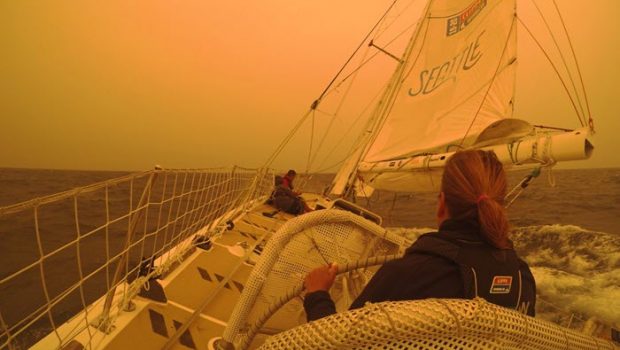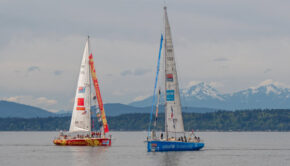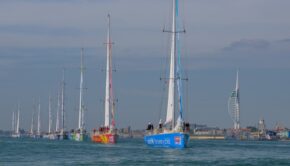Clipper Race: Challenges to remember
Published on January 5th, 2020
(January 5, 2020; Day 14) – The experience onboard during Race 5 of the Clipper 2019-20 Round the World Yacht Race will be one the crews will remember as teams report on the Southerly Busters, unpredictable currents, and bushfires providing challenging and saddening conditions along Australia’s east coast.
Opting for an in-shore route, Zhuhai’s AQP, James Finney reports: “It was time to encounter our first ‘Southerly Buster’. Sure enough, a large ominous line of cloud appeared on the horizon, Reef two in, Yankee down, and wait. You could cut the tension with a knife.
“The huge storm clouds rolling inexorably closer as we just bobbed around in front of it, the crew looking wide eyed as the sky turned darker and darker. ‘Here it comes, hold on!’ was the cry, as it bore down on top of us, with an army of white caps spray whipping off the top of them underneath. Twenty knots…that’s it? Yes that really was it. An almighty anti-climax.
“However, the Southerly did later kick in, with massive forks of lightning tearing through the night sky and gusts of over 40mph. It was more what you’d expect from one of these infamous squalls.”
Second-closest to shore is GoToBermuda with Skipper David Wavy Immelman reporting on the recent experience: “We made our way in and out of the current, with Nick and his crew on Zhuhai close on our heels, only to have the wind drop.
“I felt the temperature change and the air just felt different somehow. I called the crew up and briefed them just in case this was a Southerly Buster (a very strong wind front), but not being able to see the clouds, or anything else for that matter, I thought better safe than sorry.
“Nothing on the radar either, as you can usually see rain. Well, it paid off, the wind turned and we were hit is in true buster style. Seventy-five knots of style. We were ready, down came the Yankee 1 and in went the third Reef, and off we went like a bat out of hell.18 knots of it.”
The game of snakes and ladders is continuing as the teams navigate around, or through the middle of the interchangeable currents.
Having headed westwards after deliberating over how best to avoid the southerly currents, is Qingdao which has paid off for the team, currently top of the leaderboard. Skipper Chris Brooks explains: “I realized if we continued eastbound, we would also be the last to receive the wind coming from the south.
“We turned about, and started heading westward once more. You see, if you look hard enough, there’s a narrow corridor between two southerly avenues of tide that allow us in neutral or positive tide and also provide a good opportunity to collect the southerly breeze early.
“We are now in that southerly breeze, making 10 knots in a NNE direction so all good there. The benefit of this is that last look at the weather there appears to be an opening cut into the area of no wind. The south going breeze converges along the shore pushing its way north.”
Favoring an easterly route towards The Whitsundays, Ha Long Bay, Viet Nam’s Skipper, Josh Stickland, is hoping their tactical routing, visible on the Race Viewer will provide gains, he said: “It might make sense in the coming days. I think if I were to sum up the plan in one word, that word would be ‘ballsy’. We will see in a couple of days, if it pays off.
“We continue our relentless slog upwind, with life at an angle, but with an improving sea state it gives us a little win, so also we are trying to stay between a high and a low pressure system.”
Meanwhile, frustration is apparent onboard Unicef, with Skipper Ian Wiggin saying: “I can imagine my mum’s frustration, as her clear advice for us to sail very quickly in the right direction is seemingly being ignored.
“I am not making excuses – but I think that we must have been standing on this healed boat for too long. Now, as we try to sprint our one shorter leg is causing us to sprint in a circle.”
Currently sixth place, Seattle’s AQP, Lyndsay Barnes reflects on the situation effecting those close by: “We have been under a blanket of smoke at a very high level, but this far offshore we have not had the smell of fire that many of the other teams are reporting.
“The stress of racing fades into complete insignificance, and none of this really matters in comparison to the battle of man vs nature that is going on all over Australia at present.”
For the estimated arrival times of the fleet, click here.
Race details – Skipper list – Race route – Tracker – Facebook
Eight of the 11 teams set off on December 22 for the Leg 4/Race 5 of the Clipper 2019-20 Round the World Yacht Race, which takes the fleet 3415nm from Fremantle, Australia to The Whitsundays, Australia. The absence of three teams was due to their delay in Leg 3/Race 4 (see below) with issues requiring them to return to port, finally finishing between December 19 and 20. The three remaining teams will begin Leg 4/Race 5 on December 24. The eleven teams are expected to arrive at the Whitsundays between January 9 and 12.
Delayed: After starting Leg 3/Race 4 from Cape Town, South Africa on November 17, Unicef diverted course on November 22 to Durban for crew member Andrew Toms to disembark and receive medical treatment for a suspected appendicitis, with the team returning to the race on November 27. They finished in Fremantle, Australia on December 20 (12:24 UTC).
Collision: Punta del Este and Visit Sanya, China were in Cape Town, South Africa for repair after an incident at the start of Race 4 on November 17 resulted in significant damage. Their race finally got underway on November 28, finishing in Fremantle, Australia on December 19 (07:50 UTC) and December 20 (03:11 UTC), respectively. A review of the facts found Sanya, China to be at fault after a clear breach of the Racing Rules of Sailing (RRS) 10 ‘On Opposite Tacks’. Details.
About the Clipper Round the World Yacht Race:
The Clipper Race was established in 1996 by Sir Robin Knox-Johnston, the first person to sail solo non-stop around the world in 1968-69. His aim was to allow anyone, regardless of previous sailing experience, the chance to embrace the thrill of ocean racing; it is the only event of its kind for amateur sailors.
Held biennially, the Clipper 2019-20 Round the World Yacht Race gets underway September 1 for the fleet of eleven identical Tony Castro designed Clipper 70s. This 12th edition has attracted 688 crew representing 43 nationalities for the 41,000+ nm course. The race finishes on August 8.
The course is divided into 8 legs and 15 individual races, with some of the crew in for the entire circumnavigation while others will do individual legs. The team having the best cumulative score over the entire course will win the Clipper Race Trophy.
The Clipper 2019-20 Race Route:
The fleet departs from London, UK to Portimão, Portugal; across the Atlantic to Punta del Este, Uruguay; the South Atlantic to Cape Town, South Africa; across the Southern Ocean’s Roaring Forties to Fremantle, Western Australia; around to the Whitsundays on the east coast of Australia, back into the Northern Hemisphere to China where teams will race to Qingdao, via Sanya and Zhuhai; across the mighty North Pacific to Seattle, USA; to New York via the famous Panama Canal; to Bermuda and then it’s a final Atlantic crossing to Derry-Londonderry in Northern Ireland; before arriving back to London as fully proven ocean racers.
Source: Clipper Round the World Yacht Race












 We’ll keep your information safe.
We’ll keep your information safe.